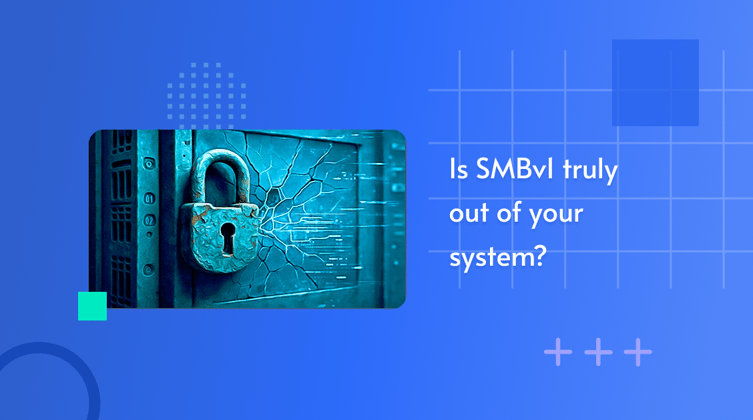Security leaders invest heavily in the front door: phishing defenses, malware de...
Why Most SMBv1 Fixes Fail — And What to Do Instead

Every organization has its unfinished business. For too many, it's SMBv1. Even years after Microsoft deprecated it, SMBv1 still lingers in enterprise networks — often out of sight, but not out of danger.
Legacy dependencies, poor visibility, and configuration drift make SMBv1 a stubborn threat. But letting it remain is no longer an option: the costs — operational, financial, and reputational — are growing fast.
All About SMBv1
SMBv1 (Server Message Block version 1) is a network file sharing protocol that was developed in the 1980s and later extended by Microsoft. It enables systems on the same network to share files, printers, and other resources.
While it was widely used in early versions of Windows, SMBv1 is now considered obsolete and dangerous. It lacks modern security features such as encryption, mutual authentication, integrity checks, and protection against man-in-the-middle attacks. These weaknesses have made it a prime target for attackers, most infamously during the 2017 WannaCry and NotPetya ransomware outbreaks, which caused billions in global damage.
Although SMBv1 is not itself a vulnerability, it plays host to many vulnerabilities and unequivocally renders the organization vulnerable. For this reason, and for its tendency to pop back up after removal, many consider SMBv1 a critical misconfiguration.
A single exposed endpoint, if not properly isolated and monitored, can lead to operational disruptions, costly recovery efforts, and compliance failures. If exploited, SMBv1 enables attackers to remotely execute code and move laterally. That gives them the keys to kingdom and the speed to go anywhere they want within it.
Because of these risks, leading security frameworks — including Microsoft, NIST, CIS, and CISA — all agree: SMBv1 must go. They recommend fully disabling it, upgrading to newer versions like SMBv2 or SMBv3, and routinely scanning for remnants that may linger in shadow IT or misconfigured systems.
The Complexities and Costs of Traditional SMBv1 Remediation
But disabling SMBv1 is rarely straightforward, requiring careful coordination across Security, Infrastructure, and IT Operations teams.
SMBv1 remediation projects can run anywhere from 5 to 12 months and cost between $475,417 and $663,750, on average. Those costs are tied to skilled labor requirements, thorough environment mapping (with shadow IT presenting a serious challenge), detailed planning, exception and workaround design and development, specialized test environments, and phased rollouts.
The extended timeline and complexity make it easy for things to fall through the cracks. And the longer the project drags on, the more consequential your interim exposure becomes. Of course, it also pulls time and focus away from other project and strategic initiatives.
In short, remediating SMBv1 is a headache, and one that’s often repeated if configuration drift brings SMBv1 back after the fact.
A Smarter Path Forward: Keep Your SMBv1 Remediation Organized and On Track
Indeed, remediating SMBv1 is a complex, multi-faceted effort, requiring coordination across teams, testing, rollouts, and constant vigilance. It’s easy to miss specific endpoints, overlook dependencies, and fail to account for the implications of user changes or third-party updates.
-1.png?width=1584&height=396&name=SMBv1-checklist-keeps-order%20(1)-1.png)
That's why we created a handy, dandy SMBv1 Remediation Checklist to help your team stay organized throughout the entire process and avoid mistakes. It breaks down each critical step, helping your team coordinate tasks, manage risks, and ensure nothing is forgotten or left incomplete.
This isn’t just a checklist — it’s your SMBv1 remediation battle plan.
Whereas an unstructured hardening project can feel like the Wild West, Remedio's step-by-step remediation checklist brings some law and order to a chaotic frontier, empowering your team to:
- Keep all tasks visible, owned, and prioritized
- Map dependencies with full operational awareness
- Strategically, identify, justify, and contain edge cases
-
Thoroughly test and validate changes before pushing them to production
-
Establish a framework for continuous monitoring to catch any re-emergence
-
Plan confidently for long-term resilience
Use it to finally say goodbye to SMBv1 and all the risk it carries — turning one of the most persistent pieces of unfinished business into a thing of the past.
Don’t let SMBv1 remain your organization’s unfinished business.
Use our checklist to finally shut the door on one of the most dangerous legacy risks in your environment — and keep it closed.
About Author

Bar Bikovsky
Subscribe to
our Newsletter
We are ready to help you until and unless you find the right ladder to success.
Related Posts
Join over 25,000 in beating the failure of strategies by following our blog.
If a threat falls in the SOC and no one ties it to revenue, does it really make ...
7 minute read
Picture the legendary Metropolitan Opera House on opening night. The air hums wi...
6 minute read
In cybersecurity, the smallest missteps can lead to the biggest breaches. Take B...








Comments